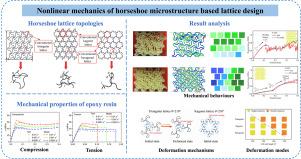Nonlinear mechanics of horseshoe microstructure-based lattice design
IF 7.1
1区 工程技术
Q1 ENGINEERING, MECHANICAL
International Journal of Mechanical Sciences
Pub Date : 2024-10-16
DOI:10.1016/j.ijmecsci.2024.109781
引用次数: 0
Abstract
Enhancing buffering capacity, flexibility, and energy absorption to withstand large deformations in structure remains a challenge. Bio-inspired horseshoe lattice structures, with their curved trusses, exhibit distinct mechanical characteristics compared to conventional metamaterials. However, their mechanical properties under in-plane compression have been rarely explored. This study characterised and modelled three types of novel 3D-printed horseshoe lattice structures, totalling 12 configurations, with unit cell geometry varying based on cell-wall angles ranging from 120°to 210°. The implementation of the FE simulation based on the three-network viscoplastic (TNV) model showed good agreement with the experiments. The results demonstrated that the cell-wall angle in the geometry and the cross-lap joint topology were significantly associated with the failure mechanism of the unit cell and the overall non-linear mechanical behaviour. Increasing the cell-wall angles can prevent beams from failing due to bending and buckling fractures, facilitate the initiation of internal contacts and stretching during in-plane compression. This reveals a configurable mechanism where the flexibility and stability of the lattice structure can trigger strain hardening, resulting in an increase in load-bearing capacity. The sensitivity to strain hardening varies depending on the order of cross-laps within the topology. A colour-pattern tracking method was employed to monitor the progressive stabilisation of lattice structures, and offering a novel approach for the future design of flexible, configurable, and programmable horseshoe-based lattice structures.

基于非线性力学的马蹄形微结构晶格设计
提高缓冲能力、灵活性和能量吸收能力以承受结构的巨大变形仍然是一项挑战。与传统超材料相比,受生物启发的马蹄形晶格结构及其弧形桁架表现出独特的机械特性。然而,它们在平面压缩下的机械特性却鲜有研究。本研究对三种新型三维打印马蹄形晶格结构(共 12 种配置)进行了表征和建模,其单元格几何形状根据单元格壁角度的不同而变化,角度范围从 120° 到 210°。基于三网络粘塑性(TNV)模型的 FE 仿真结果与实验结果吻合。结果表明,几何形状中的晶胞壁角度和交叉搭接拓扑结构与单元晶胞的失效机制和整体非线性力学行为有显著关联。增大单元壁角度可以防止梁因弯曲和屈曲断裂而失效,促进内部接触的启动和平面压缩过程中的拉伸。这揭示了一种可配置的机制,即晶格结构的灵活性和稳定性可引发应变硬化,从而提高承载能力。对应变硬化的敏感性因拓扑结构中交叉搭接的顺序而异。我们采用了一种颜色模式跟踪方法来监测晶格结构的逐步稳定,为未来设计灵活、可配置和可编程的马蹄形晶格结构提供了一种新方法。
本文章由计算机程序翻译,如有差异,请以英文原文为准。
求助全文
约1分钟内获得全文
求助全文
来源期刊

International Journal of Mechanical Sciences
工程技术-工程:机械
CiteScore
12.80
自引率
17.80%
发文量
769
审稿时长
19 days
期刊介绍:
The International Journal of Mechanical Sciences (IJMS) serves as a global platform for the publication and dissemination of original research that contributes to a deeper scientific understanding of the fundamental disciplines within mechanical, civil, and material engineering.
The primary focus of IJMS is to showcase innovative and ground-breaking work that utilizes analytical and computational modeling techniques, such as Finite Element Method (FEM), Boundary Element Method (BEM), and mesh-free methods, among others. These modeling methods are applied to diverse fields including rigid-body mechanics (e.g., dynamics, vibration, stability), structural mechanics, metal forming, advanced materials (e.g., metals, composites, cellular, smart) behavior and applications, impact mechanics, strain localization, and other nonlinear effects (e.g., large deflections, plasticity, fracture).
Additionally, IJMS covers the realms of fluid mechanics (both external and internal flows), tribology, thermodynamics, and materials processing. These subjects collectively form the core of the journal's content.
In summary, IJMS provides a prestigious platform for researchers to present their original contributions, shedding light on analytical and computational modeling methods in various areas of mechanical engineering, as well as exploring the behavior and application of advanced materials, fluid mechanics, thermodynamics, and materials processing.
 求助内容:
求助内容: 应助结果提醒方式:
应助结果提醒方式:


